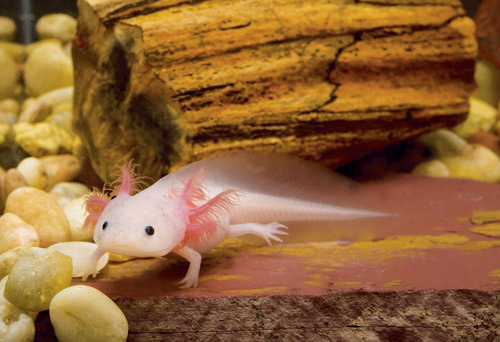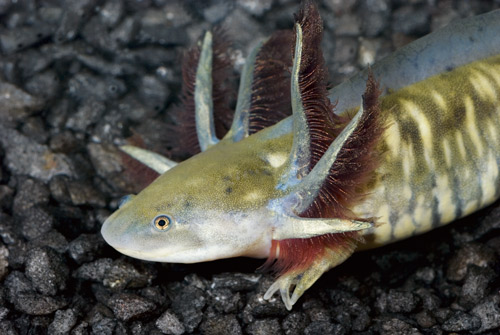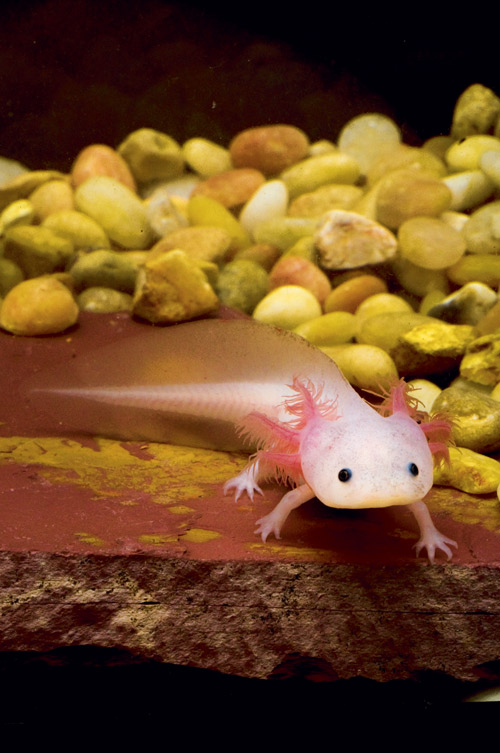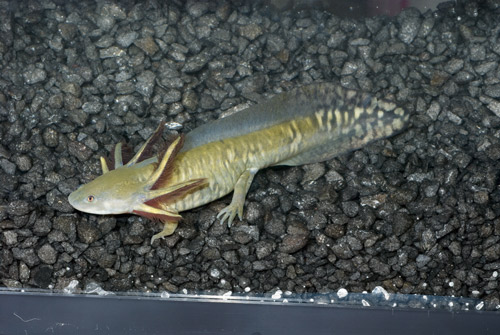When seeing an axolotl for the first time, most people find themselves fascinated.
When seeing an axolotl for the first time, most people find themselves fascinated. Is it a fish? A lizard? What are the hairy growths on its head? However they react, few people forget seeing such a weird and wonderful animal. The axolotl (Ambystoma mexicanum) is neither a fish nor a lizard. This amphibian is a large, aquatic salamander native to the waterways of Mexico City. The two bodies of water where the axolotl originated, lakes Xochimilco and Chalco, gradually diminished in size as the city grew. Today, Chalco has disappeared, and Xochimilco has been reduced to canals. Pollution and the introduction of predatory fish species have put the axolotl at the brink of extinction in the wild. Thankfully, its survival in captivity is ensured by its worldwide popularity as a pet and its scientific importance as a laboratory research animal.
What interests scientists is also a healthy advantage to the petkeeper: Axolotls can regenerate lost body parts, and they can even recover from surprisingly severe injuries. This is a useful talent for a carnivorous eating machine that doesn’t distinguish well between food, such as earthworms, and the feet of its fellow axolotls!

These salamanders produce more waste than fish, so perform water changes every two to three days in addition to using a filter.
What makes the axolotl capable of such incredible healing is also the cause of its strange appearance. Salamanders, including the more aquatic grouping known as newts, hatch from their jelly coated eggs into tadpoles known as larvae. Each singular larva possesses a pair of feathery external gills and a large fin running from behind the head, down the back and around the tail. As it grows, it gradually develops front legs and then back legs, and eventually it develops lungs. At this point, the axolotl diverges from most other salamanders. Instead of losing its fin and gills, developing a tough skin and emerging from the water to live on land, the axolotl remains a larva for its entire life and retains its ability to regenerate. It even breeds in this state. This condition is known by a number of terms, including neoteny (tending to be young), pedomorphism (retaining juvenile characteristics) and perennibranch (forever gilled). We know axolotls were once land-living salamanders, like the closely related eastern tiger salamander (A. tigrinum), but at some point, they changed to an entirely aquatic lifestyle and have kept it to this day. However, in rare instances, often by having hormones administered to them by a scientist, axolotls will metamorphose from tadpoles into land-living salamanders. A tiny percentage of axolotls are capable of metamorphosing under stressful conditions, such as deteriorating water conditions or changes in water chemistry that may promote hormone production in the body.
Types of Axolotls
Axolotls are available in a dazzling array of colors. The original axolotl, known as the “wild type,” is a brown animal with darker blotches. Albinos are golden yellow with pink eyes and red gills. Leucistic axolotls are white with dark eyes, and sometimes they have a few black markings along the top of the body. White albinos possess the leucistic and albino genes, resulting in a completely white animal with pink eyes. There are melanoid/melanistic animals that are a dark brown or black, with a bluish tinge. Melanistic albinos are also available, and these are similar to white albinos. Melanistic animals lack the reflective ring of pigment around each eye, whereas white albinos do not. Scientists recently genetically engineered an axolotl that has a small amount of jellyfish DNA. These axolotls are known as GFP axolotls, named as such because they possess a green fluorescent protein, which gives a greenish tinge to the body and results in distinctly green eyes. In the pet trade, these are often referred to as emerald-green axolotls, but this is really only true of the eyes. Scientists developed this form of axolotl for transplant and developmental experiments, because shining an ultraviolet light reveals the green color, allowing easy tracking and identification of tissue originating from a GFP donor animal.
There are slight color variations on the forms just described, but there are also piebald axolotls and an extreme form, which combines a piebald appearance with patches of orange. This last type is known in the hobby as a harlequin, and it is very hard to come by.

Unlike most salamanders, axolotls remain in their aquatic form for life.
Acquiring an Axolotl
Look for active animals with all of their limbs and their fin intact, and a bushy set of gills. A healthy axolotl will be slightly plump and always interested in food. Avoid axolotls with discolored or opaque eyes, any hairy growths on the body (these could be a fungal or bacterial disease), forward-curling gills or curled tail tips. All of these are indicators of potential health problems. Quarantine new acquisitions in a different aquarium for at least a month to limit the chances of passing any diseases on to axolotls you already own. Axolotls aren’t territorial, but they do think with their stomachs and may make a meal of their tankmates, particularly when they are young.
Male axolotls are more slender than females, and they often have proportionately longer tails. Adult males also have a more enlarged cloaca (the bulge directly behind where the back legs meet the body) than females. Mature females are often decidedly round at the hindquarters due to eggs. Don’t worry about female axolotls not laying — unlike with reptiles, egg binding is not a true health concern in the majority of amphibians.
Axolotls are rarely available at pet stores, but many pet stores can order them if you ask. Breeders usually sell their youngsters through the Internet, and buying from a breeder generally ensures a healthy animal that has received the best care. In the continental United States, California and New Jersey prohibit the possession of axolotls, even as pets, due to the concern of axolotls interbreeding with their wild, native relatives, such as the critically endangered California tiger salamander (A. californiense), and in New Jersey, the eastern tiger salamander (A. tigrinum), which is not endangered. Check your local laws before acquiring an axolotl.
Transport axolotls the same way you would fish — minimize sudden temperature changes by keeping them in an insulated box, and keep trauma to a minimum by covering the container so the axolotl can’t see out.

Leucistic axolotls are white with dark eyes, and sometimes they have a few black markings along the top of the body.
Keep It Cool
Axolotls require water temperatures below 75 degrees Fahrenheit. They invariably succumb to anorexia, disease and death if kept above this temperature for more than a day or two. Sudden temperature changes can also lead to health problems and death, so attempting to cool your aquarium quickly on a warm day might be worse than leaving it alone. Axolotls thrive at temperatures between 50 and 72 degrees. They tolerate near-freezing conditions well, and there is scientific evidence that wounded and sick axolotls heal more efficiently at low temperatures. Many successful axolotl breeders keep their axolotls in their basements. This allows the temperature to change with the seasons, invariably resulting in egg laying in late winter and early spring. If you encounter unexpectedly warm temperatures that put your axolotl at risk, keep some soda bottles filled with tap water in your freezer. Floating a bottle like this in an aquarium can help control warm temperatures. Having a couple of bottles in rotation — one in the freezer and one in the aquarium — can be a real lifesaver during the summer months. For gentler cooling, keep a bottle in the coolest part of your refrigerator rather than the freezer.
Have your aquarium set up and aged long before acquiring an axolotl. Axolotls can attain a total length of 10 inches or more. Occasionally, they grow much larger. I once photographed a 17-inch monster in Germany. Large, aquatic salamanders require suitably large aquariums, and their voracious, carnivorous diet means they can produce a lot of waste, which can quickly foul small aquariums. At a bare minimum, you can accommodate a single adult in a 10-gallon aquarium. However, it is particularly challenging to maintain good water quality in such a small tank, and a 20-gallon aquarium is a more reasonable starting point for one to two adult axolotls. Choose long aquariums over tall ones, because axolotls spend the majority of their time walking around on the bottom. The greater the water volume, the more stable the water conditions and the better the water can handle waste produced by your pet. Water level is not very important, but aquariums look their best when filled completely.
Water quality is an essential consideration when keeping axolotls. They breathe using their gills, which extract oxygen from the surrounding water and excrete carbon dioxide and other substances. They also carry out some gaseous exchange through their permeable skin. Once an axolotl has all of its legs, it grows small but functional lungs. These lungs allow your axolotl to take a gulp of air from the surface on occasion and use its lungs to supplement its oxygen requirements, which are primarily met by still using its gills. If you see your axolotl taking more than a couple of trips per hour to the surface, it may be a sign of poor water conditions. While more forgiving of fluctuations in water quality than fish, axolotls require clean water. This means using a dechlorinator to remove harmful substances from tap water and either a filtration system like those used for fish or complete water changes every few days. Axolotls prefer slightly alkaline water (pH above 7.0) that has some dissolved calcium and magnesium salts — the substances that cause lime scale in your bathtub. These conditions are often found in municipal tap water, but you can purchase products at your local aquarium retailer to bring less-suitable water into line with an axolotl’s requirements, and you can also purchase test kits to assess water chemistry. To minimize shock, perform water changes using water of similar properties and temperature to that already in your aquarium.
Performing complete water changes every two to three days is hard work, so most petkeepers use a filter. Filters for fish aquariums are ideal, but axolotls produce much more waste than your average fish, so consider a filter that can handle a larger volume than recommended for fish aquariums. I would choose a filter recommended for the next size up of aquarium from the aquarium being used.
Aside from the risk of high temperatures, the second most common culprit in axolotl deaths is water flow. Axolotls come from still-water lakes, and flowing water is stressful to them. An axolotl exposed to strong water flow, such as that produced by a direct filter output, will almost invariably go off its food, lose weight and succumb to bacterial septicemia. Therefore, if you employ a filter, consider one that has an output that can be regulated or directed at the glass in order to reduce direct water flow around the aquarium. An ideal solution is a spray bar. This is a plastic tube with holes along its length that attaches to the outflow of a filter. It allows you to spread the outflow along an aquarium wall. Some filter manufacturers sell dedicated spray bar kits for their products, particularly for canister filters, which makes dealing with flow problems relatively straightforward. A sure warning sign of an axolotl stressed by strong water flow is forward curling gills, so keep a close eye on your axolotl when your aquarium is first set up.

This unusual salamander can actually regenerate lost body parts.
Axolotl Ambiance
Suitable substrates for axolotl aquariums include aquarium sand and large pebbles. The gravel sold for aquarium fish is not suitable for axolotls because they invariably swallow it, even if you have never seen them do so. If gravel is smaller than the axolotl’s head, then there is a good chance your pet will be able to swallow it. There are regular reports of intestinal blockages in axolotls, known as impactions, caused by gravel, and these often lead to death.
Axolotls have a habit of uprooting and damaging aquarium plants, so if you decide to use plants, choose tough ones that can survive without permanent roots. Plants like java moss (Vesicularia dubyana) are good choices, because they not only survive the attention of axolotls, but are also used by axolotls as a place to affix their eggs. Plants need lighting, and the axolotl hobbyist likes to see his or her pet, so when purchasing your aquarium, get an appropriate canopy with a fluorescent bulb in a plant-friendly spectrum range, between 4,200 and 6,700 kelvins. Avoid incandescent bulbs; they can heat the aquarium, stressing your axolotl as discussed earlier.
It is tempting to keep other animals with axolotls. Unfortunately, even though I do not recommend feeding your axolotls fish, they will eat them, and fish like to nibble on axolotl gills. This is true for most tankmates. The axolotl or the tankmate is eventually injured or dies. Keeping axolotls together is the safest course of action. Bear in mind that axolotls, particularly when young, will make a meal out of their tankmates’ legs and fins, and keeping axolotls of very different sizes together can end in disaster. Adult axolotls rarely harm other adults and make good tankmates.
Enthusiastic Eaters
Axolotls accept a wide variety of foods, and with the exception of hatchling axolotls, they accept non-living foods with gusto. Good staple foods include nightcrawlers and the pellets sold for feeding fish farm salmon and trout. Many breeders rely solely on these pellets, and they will usually sell them to you. I use pellets sold as Newt and Salamander Bites for juveniles. These pellets are available at most pet stores. Foods suitable for occasional treats include frozen bloodworm cubes, blackworms, frozen shrimp and even lean red meat, such as beef heart. Like other salamanders, and unlike dart frogs, for example, axolotls do not require vitamin and mineral supplements.
Axolotls are notorious for their appetites, so never feed more than your pet will eat in 15 to 20 minutes. Feed young axolotls daily and large juveniles and adults every two to three days. While youngsters can’t be left unfed for more than a day or two, well-fed adults will be fine for a week if you need to go on vacation.
Close Relatives
There are several close relatives of the axolotl that also remain as larvae throughout their lives. One of these is the Anderson’s salamander (Ambystoma andersoni), and it has recently made its way into the pet trade. These salamanders resemble a strikingly colored, wild-type axolotl. They possess more vivid contrasts in color, as well as extra color tones on the body. Wild-type axolotls are usually brown and black, with little contrast between the two. Anderson’s salamanders have noticeable contrast, and they have orange color in there, too. They also have bushier gills than an axolotl. They require identical care and have an increased tendency to metamorphose into terrestrial salamanders. Terrestrial axolotls require similar care to tiger salamanders, and tiger salamander larvae resemble axolotls and are often sold as such, sometimes under the monikers “waterdog” or “baby dinosaur.” These tiger larvae require the same care as axolotls, but make sure you are prepared with the right enclosure for when they change into land-dwelling salamanders.
Healthy axolotls can live up to 10 years or more. They make fascinating and unusual pets. If fed well, they can reach maturity in as few as six months and breed within a year.


